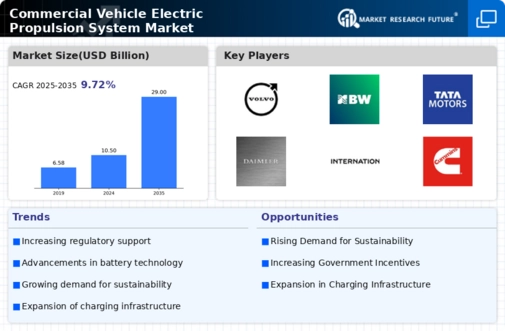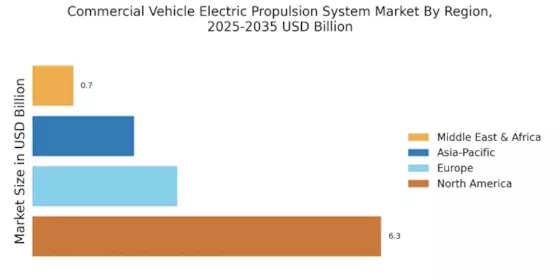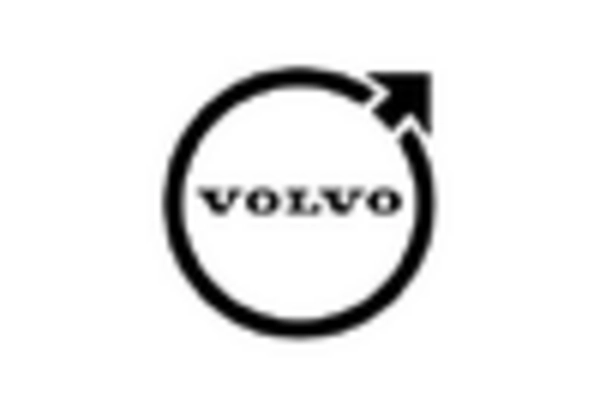Regulatory Framework and Incentives
The Commercial Vehicle Electric Propulsion System Market is significantly influenced by regulatory frameworks and incentives aimed at reducing carbon emissions. Governments are implementing stringent emission standards and offering financial incentives for the adoption of electric vehicles. For example, tax credits, grants, and subsidies are being provided to businesses that invest in electric commercial vehicles. This regulatory support not only encourages manufacturers to develop electric propulsion systems but also motivates fleet operators to transition from traditional diesel engines to electric alternatives. As a result, the market is expected to witness a steady increase in electric vehicle registrations, contributing to a more sustainable transportation ecosystem.
Cost Competitiveness of Electric Vehicles
The Commercial Vehicle Electric Propulsion System Market is also being driven by the cost competitiveness of electric vehicles compared to their internal combustion engine counterparts. As battery prices continue to decline, the total cost of ownership for electric commercial vehicles is becoming more attractive. Fleet operators are increasingly recognizing that electric vehicles can offer lower operating costs due to reduced fuel expenses and maintenance requirements. This economic advantage is likely to accelerate the transition to electric propulsion systems in commercial vehicles, as businesses seek to optimize their operational efficiency and reduce long-term costs. The trend suggests a promising future for electric vehicles in the commercial sector.
Infrastructure Development for Electric Vehicles
The Commercial Vehicle Electric Propulsion System Market is being bolstered by the ongoing development of charging infrastructure. The expansion of charging networks is critical for the widespread adoption of electric commercial vehicles. Investments in fast-charging stations and depot charging solutions are making it easier for fleet operators to integrate electric vehicles into their operations. Furthermore, partnerships between public and private sectors are facilitating the establishment of comprehensive charging solutions, which are essential for long-haul operations. As infrastructure continues to improve, it is expected that the market for electric propulsion systems in commercial vehicles will experience accelerated growth, driven by increased accessibility and convenience for users.
Technological Innovations in Electric Propulsion
The Commercial Vehicle Electric Propulsion System Market is experiencing a surge in technological innovations, particularly in battery technology and electric drivetrains. Advancements in lithium-ion batteries, solid-state batteries, and energy management systems are enhancing the efficiency and range of electric commercial vehicles. For instance, the energy density of batteries has improved significantly, allowing vehicles to travel longer distances on a single charge. This is crucial for logistics and transportation companies that rely on long-haul operations. Furthermore, the integration of smart technologies, such as vehicle-to-grid systems, is enabling better energy utilization and cost savings. As these technologies continue to evolve, they are likely to drive the adoption of electric propulsion systems in commercial vehicles, thereby expanding the market.
Growing Demand for Sustainable Logistics Solutions
The Commercial Vehicle Electric Propulsion System Market is witnessing a growing demand for sustainable logistics solutions. Companies are increasingly recognizing the importance of reducing their carbon footprint and enhancing their corporate social responsibility. This shift is prompting logistics providers to invest in electric commercial vehicles as part of their sustainability initiatives. According to recent data, the logistics sector is projected to see a substantial increase in electric vehicle adoption, with estimates suggesting that electric trucks could account for a significant share of the market by 2030. This trend is likely to drive innovation in electric propulsion systems, as manufacturers strive to meet the evolving needs of environmentally conscious consumers.


















Leave a Comment